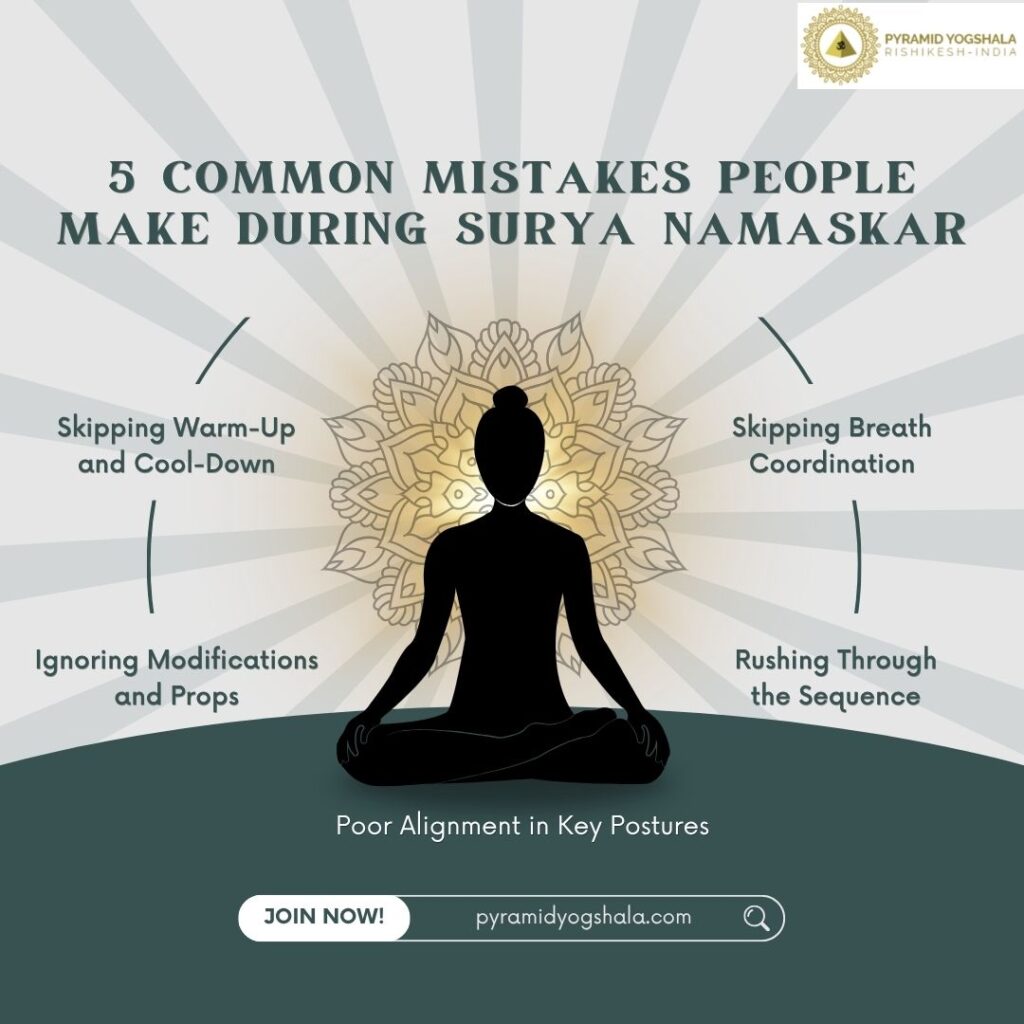Surya Namaskar, or Sun Salutation, is much more than just a warm-up sequence. Practiced for centuries in yogic traditions, it combines 12 powerful asanas (poses) that activate almost every part of the body. When done correctly, Surya Namaskar improves flexibility, balances the doshas, enhances metabolism, and nurtures the mind-body connection.
However, despite its ancient roots and simplicity, many practitioners—especially beginners—end up doing it wrong. At Pyramid Yogshala, we often see common mistakes that limit the benefits or even cause discomfort and injuries. If you’re looking to improve your practice, here’s what you need to know.
Why Proper Form in Surya Namaskar Matters
Surya Namaskar is a dynamic blend of forward bends, backbends, inversions, and breath coordination. Every movement has a purpose—be it activating the spine, strengthening the core, or calming the nervous system. Even small misalignments in this sequence can strain the knees, shoulders, neck, or lower back.
According to the Ministry of AYUSH, India (2024), a properly executed Surya Namaskar can burn up to 13.9 calories per set and improve cardiovascular endurance when practiced regularly. But to unlock these benefits, precision and mindfulness are key.

Mistake 1: Skipping Breath Coordination
Many practitioners focus only on physical movements and forget the breath synchronization that lies at the heart of Surya Namaskar. Each asana in the sequence is paired with either inhalation or exhalation.
Why it matters: Incorrect breathing disrupts the energy flow (prana) and makes the practice feel tiring instead of energizing.
How to fix it:
- Inhale during upward and opening postures (e.g., Hastauttanasana).
- Exhale during compressive or downward movements (e.g., Padahastasana, Parvatasana).
- Practice slow, deep breathing to build awareness.
Mistake 2: Rushing Through the Sequence
In the fast-paced world of YouTube yoga and fitness apps, Surya Namaskar is often treated like a race. People rush through all 12 poses without settling into each one.
Why it matters: Speeding through the sequence increases the risk of injury and defeats the meditative quality of the practice.
How to fix it:
- Focus on holding each pose for one full breath cycle.
- Start with 4–6 slow rounds before attempting faster-paced flows.
- Remember, yoga is not about how fast you go, but how aware you are.
Mistake 3: Poor Alignment in Key Postures
Improper alignment is a silent saboteur. In poses like Chaturanga Dandasana (low plank) or Ashwa Sanchalanasana (equestrian pose), poor form can damage wrists, shoulders, or the spine.
Why it matters: Repeating misaligned postures builds bad habits and can lead to chronic strain or injuries over time.
How to fix it:
- In Chaturanga, keep elbows close to your body and aligned over wrists.
- In Ashwa Sanchalanasana, ensure the front knee is stacked over the ankle.
- Practice in front of a mirror or under a certified yoga teacher, like those at Pyramid Yogshala.
Mistake 4: Ignoring Modifications and Props
Beginners often feel pressured to match advanced poses they see online. But not everyone has the same strength, flexibility, or stamina.
Why it matters: Forcing your body into a posture before it’s ready can cause tension or pain.
How to fix it:
- Use blocks for Padahastasana if you can’t reach the floor.
- Modify Chaturanga by dropping the knees.
- Do fewer rounds and rest between sets if needed. Yoga is a journey, not a competition.
Mistake 5: Skipping Warm-Up and Cool-Down
Jumping straight into Surya Namaskar without prepping your joints can shock your system. Similarly, ending the practice abruptly without cooling down is equally harmful.
Why it matters: Without warm-up, your muscles are stiff. Without cool-down, your nervous system stays on high alert.
How to fix it:
- Begin with gentle joint rotations or cat-cow stretches.
- End with a brief Savasana or seated meditation to balance your energy.
- At Pyramid Yogshala, our classes always include preparation and closure for a holistic experience.
Latest Research on Surya Namaskar (2024 Update)
Recent studies from the International Journal of Yoga Therapy (2024) have shown that daily practice of Surya Namaskar for 12 minutes can reduce anxiety, enhance sleep quality, and improve balance in elderly populations. Another study highlighted its role in managing type 2 diabetes and hypertension when combined with breathwork and lifestyle changes.
Conclusion: Practice with Awareness, Practice with Purpose
Surya Namaskar is a timeless sequence—but its benefits unfold only when done with alignment, breath, and intention. Avoiding these common mistakes can transform your practice from routine to rejuvenating.
At Pyramid Yogshala, our experienced instructors ensure that each student learns the right technique at their own pace. Whether you’re a beginner or a seasoned yogi, Surya Namaskar has something to offer when practiced mindfully.

